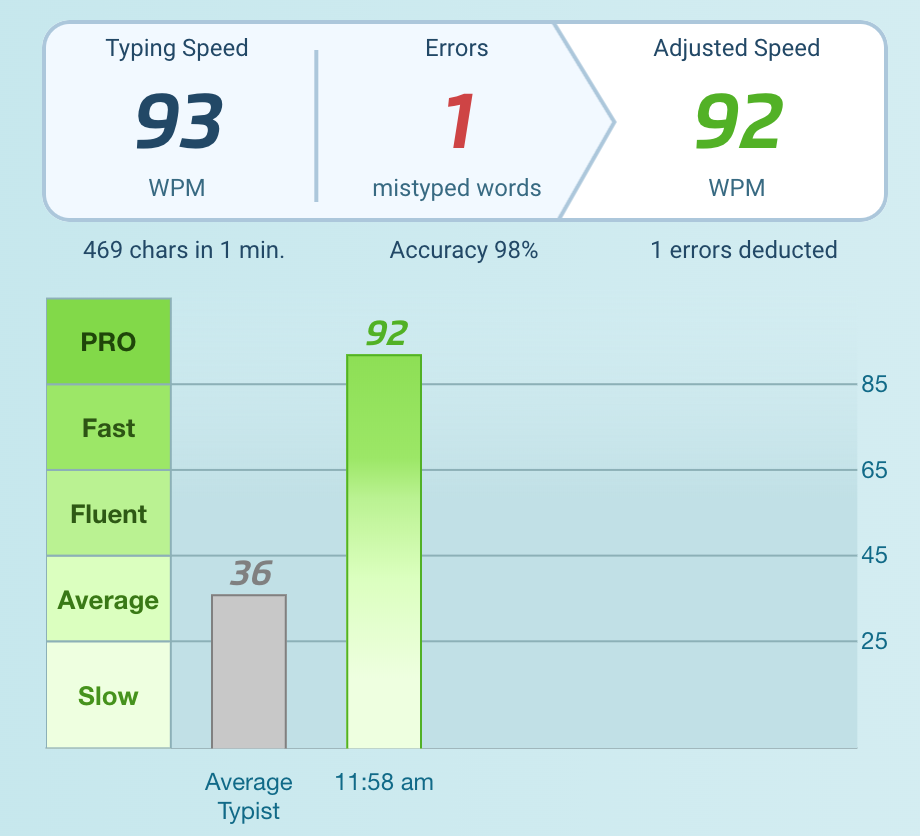Here’s some simple math: If you type 30 words per minute, then a 300-word email will take you 10 minutes to write. But if you can type twice as fast, you can crank it out in five. That’s a lot of minutes saved if you write a lot of emails — or do anything else that requires you to type words on a screen.
With all the productivity hacks out there for managing your time — simplifying your inbox, time blocking, optimizing your meetings — typing faster seems like the obvious, low-hanging fruit. But it’s fruit that many people aren’t reaching for. As the MIT Tech Review has noted, touch typing has fallen out of favor and many schools are no longer teaching it. You probably type at the same speed that you did when you were in high school, and you assume that it’s working out for you just fine.
Trust me, it’s not. Your slowness is costing you. Dearly. You just never realized it. You don’t see the person at the other end of your email typing at twice your speed and therefore getting more done. But that’s what’s happening. When it comes to small tasks at work, speed matters.
As the writer John McDermott laid out in Mel magazine, if you’re an average typist at 40 words per minute (WPM) and you write about 2,000 words per day — whether you’re writing code, messaging colleagues on Slack, posting Tweets and Instagram captions — then by increasing your speed to an above-average 70 WPM, you can save yourself four whole days a year.

A couple studies that emerged over the past five years suggest that two-finger typers — the so-called “hunt-and-peckers” — can work their way to similar typing speeds as 10-finger touch typers. But as Typing.com puts it, “hopping from one key to the next with the same finger is almost like trying to pedal a bike with one leg.” You could learn how to do it pretty quickly, but you’ll never be as fast as if you placed both feet on both pedals.
Luckily, if you never learned how to type correctly, you can get the gist of touch typing in about four minutes. Here’s a graphic to explain how it works:

This simple, color-coded keyboard is at the heart of every touch typing class. Print it out and hang above your desk. Study it for a few minutes each day, and use it as a guide.
The idea is that each finger is responsible for one diagonal column on your keyboard, with the exception of your thumbs, which only cover the space bar, and your index fingers, which cover two columns each. Place your fingers on the keyboard. Your index fingers go on the F and J button — there are bumps on those keys to guide you — the others in a row alongside them. Try to only move up and down with each finger.
There are also plenty of free typing trainers online, like this one, which cover the basics and provide short practice lessons based on the diagram. And it helps to play a typing game for five to 10 minutes each day (in TypeRush, you can virtually race cars and boats against others — it’s fun). Test your typing speed weekly, track your best WPM out of three runs, and watch your accuracy and pace increase over time.
The reason why I’m writing about this seemingly basic skill is that most people won’t take the time to learn it. Why? First, as I mentioned, your current speed and system probably feels good enough to you.
Then, of course, there’s effort barrier. Like learning a language, typing is a skill that’s much easier to master when you’re young, and you may not be sure that the work of picking it up now is worth the reward.
Finally, learning touch typing will at first slow you down. Not everyone’s willing to make that temporary sacrifice.
But again, the math is simple. Another way to frame it: If you spend one hour a day typing, which is a conservative estimate, doubling your typing speed will save you 30 minutes every single day. So stick with the process, keep practicing, and follow the rules. The diagram might be coded in rainbow colors, but what lies at the end of it — more time — is better than gold.
